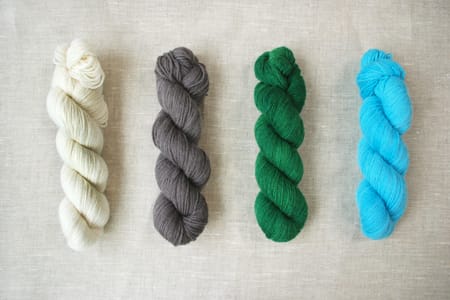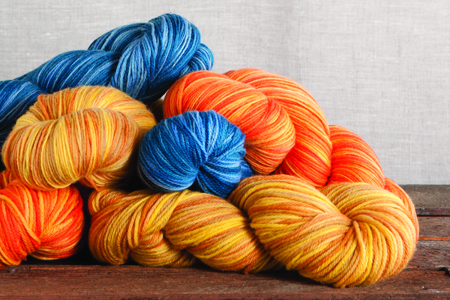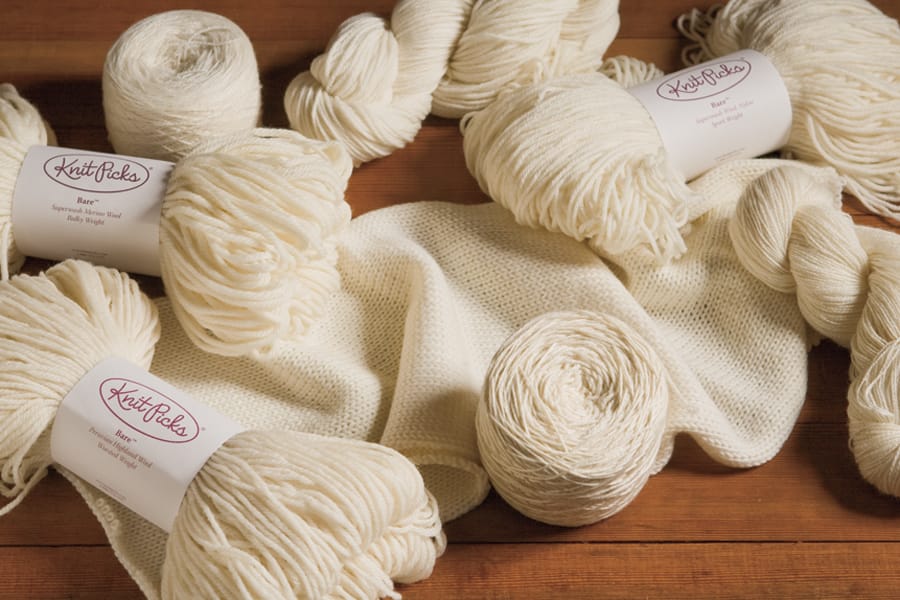Attention sweater and garment knitters – we have some news that you are going to LOVE! We literally searched the world over to bring you these gorgeous custom buttons, hand-dyed to match our Wool of the Andes, Palette, and Swish yarns. Each button is formed from the corozu nut – also known as tagua – a durable, sustainable product that is scratch resistant and has an elegant natural grain.
Read more »Search Results for: dye
Back in the day, before Photoshop was my artistic tool of choice, I loved to paint. Oil, acrylic, watercolor and charcoal delightfully muddied up my bedroom. These days, my home is cluttered with a different method of creative expression: yarn dyeing! 
I started with a just a few colors in Greener Shades Dye, several skeins of Knit Picks Wool of the Andes Superwash Bare yarn and this trusty guide: Hand Dyeing Yarn and Fleece. I’m not gonna lie; I was intimidated by the whole process. I felt the ‘blank canvas’ paralysis of days gone by returning. However, after I took the plunge (or rather, my first skein took the plunge), the fear vanished and the fun began!
 yarndyeing" width="600" height="388" srcset="https://eore4vit998.exactdn.com/wp-content/uploads/2016/07/yarndyeing2.jpg?strip=all&lossy=1&ssl=1 ...
yarndyeing" width="600" height="388" srcset="https://eore4vit998.exactdn.com/wp-content/uploads/2016/07/yarndyeing2.jpg?strip=all&lossy=1&ssl=1 ...
Summer is my favorite time to work on dye projects and today is the last day to save 30% on our range of dyes for natural fibers!
Read more »
Last summer I was lucky enough to be able to take a day long class at the Wildcraft Studio School about an hour and a half outside of Portland. It was so nice to be able to spend the day outside exploring the woods and gathering plants with a group of other people interested in natural dyes and I came away with some insight into where I can find some of these plants on my own. I’ll be talking about dyeing with Blackberry, Sheep Sorrel, Horsetail, Lupine and Fennel on wool yarn and silk fabric.
Have you ever heard of idyes? Me, neither! Alison, our fearless Knit Picks Director, tells me that they’re acid dyes (like the kind Kim uses) but have a combination of cellulosic dye (for plant fibers such as cotton) and protein fiber dye (for animal fibers like silk), allowing you to use them on a large range of natural fiber projects. Inside each envelope is a little water-soluble packet (kind of like those dishwasher detergent nuggets) which you just pop into your washing machine and Vwalaa! You’ve dyed your own yarn. I asked her to describe her process and take some photos. Here we go!

From Alison: “IDye packets can be a nice option for folks who
Read more »Have you ever dyed fiber with Jaquard Acid Dyes? Neither have I! Kim here at Knit Picks is a pro, though. So I asked her to do some dyeing and take some photos, and she made it looks so easy! She has two methods: one uses a crockpot and takes about 3 hours (including cooling time) and one uses a microwave and takes about (wait for it) 4 minutes! Can you believe it? It’s totally clean and easy, too. Here’s Kim’s description of each method:
From Kim: “I love to dye fiber! The bolder the better! Here I’m showing you two techniques that I used with wool fiber.
Read more »This week we’re celebrating the dyeing process. Do you know anything about dyeing yarn? I know nothing. Hannah here at Knit Picks does, though! She even took a class on natural dyeing. So I asked her to show me how to dye yarn from a few blossoms she found in her garden and it was so easy I couldn’t believe it. She wrote up the details and I made a video. Click through if you’d like to see!

Harvesting: “I picked both Hollyhock (left) and Marigold (right) flowers from my garden in August.
Read more »When Bare Hare arrived to at our office, everyone’s first reaction was to uncontrollably “ohhh!” and “ahhhh” over how incredibly squishy and soft it was. Then almost immediately afterward, it seemed as though the same idea popped up for everyone at the same time – Bare Hare is an undyed yarn, which means you can dye it whatever shade is your color of choice! All of us have had previous dyeing experience and so of course, we couldn’t help but jump over to the dyeing section of the Knit Picks website to check out the different dyes and colors.
In addition to the Jacquard dyes, we were also drawn to the Earthues and Greener Shades dyes. And because we loved Bare Hare so much, we thought – why not experiment a bit and try out all three different types of dyes? I had been wanted to try out the Greener Shades Dyes, so I opted for the Coral Reef Aqua. Stacey chose Emerald in the Jacquard Dyes and Kerin went with the Earthues natural dyes.
Here is the result of our Bare Hare dyeing extravaganza, I love how they turned out!
Read more »Have you seen our new selection of tonal yarns yet? There are so many reasons to love adding the subtle shifts of color found in tonal yarns into your projects. Tonal yarns are a wonderful way to add the subtle variations of a color to your project without fearing that it will distract from textured stitches, cables, or even lace patterns. Each of our tonal yarns are made up of seven different shades of your favorite colors, which combine together to create complex, monochromatic colorways. Not only do tonal yarns add lots of visual interest when worked up with simple stitches, but they also beautifully highlight intricate stitch patterns.
Read more »As the sugar high of chocolate, jelly beans, and Peeps finally wears off, you might find a box or two of leftover Easter egg dye lying around the kitchen. Instead of tossing them back in the cupboards, grab some of your favorite Bare yarns and start dyeing! You might be surprised to learn that a lot of unconventional dyes, like Easter egg dye and food coloring, are a wonderful way of dyeing protein based fibers like wool, alpaca and silk. In addition to being inexpensive, these are dyes you can easily find at your local grocery store. Another great thing about dyeing with Easter egg dye and food coloring is that these are nontoxic dyes, making them ideal for a fun afternoon crafting project with children. And if you are anything like me, you might already know that right after the holiday is the best time to stock up on Easter egg dye packages for year-round yarn dyeing fun!
Read more »






